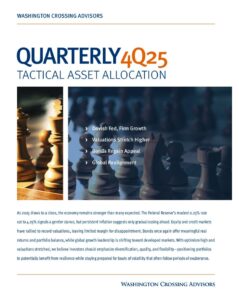Insight & Commentaries
Global growth is picking up. At Jackson Hole, Janet Yellen said the case for a rate increase is stronger, given the recent pickup in data. It appears that earlier concerns that Brexit would hurt near-term growth were misplaced. Weak productivity growth, a clouded earnings picture, and lackluster investment remain long-term concerns. This week’s data will provide further insight into employment and manufacturing trends. The Federal Reserve of Atlanta’s “GDP Now” estimate of Q3 GDP is 3.6%. Private forecasters seem to be raising their growth forecast toward 3%. This is a big improvement from last winter’s 1% growth environment. Steady consumer demand, coupled with…
The Federal Reserve (Fed) releases the minutes from July Federal Open Market Committee (FOMC) meeting on Wednesday. MACRO VIEW Credit spreads are tighter. Commodity prices are firmer. More stocks are participating to the upside. Financial conditions within the banking system are improving. These are some of the “high frequency” items that are on the mend this year. As this happens, equity markets are performing better. Our own WCA Fundamental Conditions Barometer (below) is telling a similar story. Around the time markets began to price in a less-hawkish Fed earlier in the year, conditions began to firm. Commodities ended their freefall. …
The data supports an economy gathering momentum into the third quarter. This week brings some additional data on retail sales and consumer sentiment. MACRO VIEW The July employment report was strong. Jobs rose 255,000 in the month, adding to the 292,000 increase in June. These increases contrast sharply with the 84,000 average job gain in April and May. The strength in jobs suggests income and spending are also picking up. The Federal Reserve of Atlanta now estimates the economy will grow 3.8% in the third quarter. Growth averaged just 1% in the fourth quarter of 2015 and first quarter 2016….
Friday’s July employment report is the big number this week. This indicator is a focal point for the Federal Reserve (Fed) and has been very erratic of late. The 6,000 job loss in May was shockingly poor, but it was followed by a better-than-expected 265,000 job gain in June. Will the real labor market please stand up? A Bloomberg survey reveals a street expectation of 171,000 jobs and a 4.8% inflation rate. MACRO VIEW Last week’s Gross Domestic Product (GDP) report showed an economy growing at just 1.2%. This headline figure will be revised further, but taken at face value,…
Earnings season continues. According to FactSet, analyst expectations are for another decline (approximately -5% )in second quarter earnings, but forward earnings expectations are firming up. The Fed meets this week — no rate change expected. Earnings and Valuations Focus The rally of the last several sessions is being helped by a firming of earnings forecasts. Just how much improvement in earnings is expected, and what will the market be willing to pay for those earnings? According to FactSet, analysts increased their forward 12-month S&P 500 operating earnings number to $127 in June from $124 back in February. Viewed in a…
The Republican National Convention kicks off in Cleveland this week. Expect politics to dominate headlines. Meanwhile, the basic pattern in the data still suggests an improving economy as we head toward the fall. MACRO VIEW The market’s rally of late is accompanied by improvement in the WCA Fundamental Conditions Index*. Through May, the index rose to 45 and is likely to break above 50 by the time all of the data becomes available. Earnings forecasts for the S&P 500 are up four straight months, along with some surveys of business expectations. Oil prices are no longer at lows. Expectation of…
Last week’s jobs report was solid. A total 287,000 jobs were added in June, bringing the quarterly average to 147,000 per month. The June number follows a very weak May reading, however. There is considerable volatility in the month-to-month data, so it is important not to become overly fixated on one month. Comparing the second quarter average job gain of 147,000 to last year’s second quarter job gain of 205,000 paints a weaker picture. Overall, we see an economy that is still expanding but, as a result of slower global growth, has downshifted into a slower gear. Our hypothesis, that…
Britain’s decision to leave the European Union (EU) reflects widespread dissatisfaction with EU governance. The rejection of EU governance highlights the inherently unstable nature of the organization. If individual members experienced long-run benefits, defections would not occur. Instead, the people of Europe would press for a formal merger. If individual members become dissatisfied, these countries are likely to break away. Why would a dissatisfied and democratic country like the United Kingdom look to remain? Most, including us, believed the vote would lean toward maintaining the status-quo. This exit vote marks the first tangible step backward from the decades old vision…
This week’s data includes a look at consumer prices and industrial production on Tuesday. Each is relevant given recent below trend growth in fundamental data. MACRO VIEW Headline consumer prices (CPI) in the last year were pressured by a sharp decline in the energy component of the index. Stripping out energy (and food), core underlying inflation trends appears stronger (second chart, below). The core inflation numbers tend to be the ones emphasized most by policy makers, however. The rise in current core inflation trends stand at odds with overall inflation and future expectations for falling headline inflation (bottom chart, below)….



